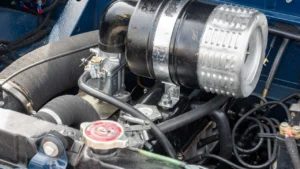
Performance is at the heart of the all-new Mustang GTD, but its artistry and craftsmanship are equally striking, showcased by a cabin that highlights its state-of-the-art, race-ready suspension.
“The rear suspension is designed for performance, but it’s also a beautiful piece of engineering,” said Jim Owens, Mustang GTD marketing manager. “We didn’t want to hide it away. With the suspension window, owners can admire the blue and gold accents on the dampers without removing the tech panel, and passengers can watch the suspension in action.”
The suspension window, roughly 24 inches wide by 10 inches tall, is made of polycarbonate with a scratch-resistant coating on both sides. This design element showcases the engineering teams’ hard work like a finely crafted precision timepiece.
“With a car as capable as the Mustang GTD, we wanted to create something that’s just plain cool and owners will appreciate,” said Owens.
Race-Proven Technology
From active aerodynamics to a carbon-fiber body, magnesium wheels, and a rear transaxle, the 2025 Ford Mustang GTD is a showcase of race-proven technology driving the development of road-going vehicles. The centerpiece of this race-to-road innovation is the semi-active suspension, making it the most track-capable production Mustang ever.
“We’ve never done a suspension like this on Mustang,” said Greg Goodall, Mustang GTD Chief Program Engineer. “To meet our aggressive lap time targets, we looked to motorsports for inspiration to develop something really advanced. This cutting-edge suspension and advanced dampers are key to transforming a Mustang into a Mustang GTD.”
The Mustang GTD’s inboard rear suspension, where the shocks and springs are positioned low and between the rear wheels rather than above them, exemplifies Ford’s application of track-derived technology to road vehicles. Combined with a strong, stiff, and weight-efficient motorsport-style tubular subframe, the track DNA in the Mustang GTD’s rear end is evident. Multimatic’s proprietary Adaptive Spool Valve dampers go beyond what’s allowed in racing.
Capable of adjusting from their softest to firmest setting in just 15 milliseconds – six times quicker than the human eye can blink – the ASV dampers continuously adapt based on drive mode, road surface, and driver inputs to maximize the Michelin tires’ contact with the road.
“Adaptive damping offers more flexibility in absolute ride performance compared to a passive damper,” said Scott Keefer, vice president of Multimatic engineering. “It lets you decouple the ride versus handling compromise usually made in damper tuning. Our system is a double win, with adjustments feeling very natural in terms of motion control.”
Each damper has two springs. When driving on the street, they work together for a comfortable ride. Activating the driver-selectable Track mode hydraulically compresses one of the springs, nearly doubling the spring rate and lowering the vehicle by about 1.6 inches to maximize track performance.
The stiffer spring rate enhances mechanical grip, and like a race car, firmer springs improve aerodynamic grip too. As the Mustang GTD’s active aerodynamics press down on the car at high speeds, the firmer spring rates in Track mode counter aerodynamic squat, keeping the tires’ contact patch broad during acceleration, braking, and cornering.
The Mustang GTD will make appearances at the 24 Hours of Le Mans in June, the 24 Hours of Spa, and the Goodwood Festival of Speed. It will also undergo summer testing in Europe before attempting an officially timed sub-seven-minute lap of Germany’s legendary Nurburgring Nordschleife later this year.







